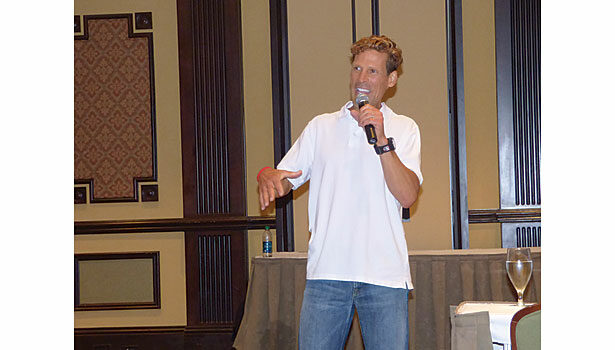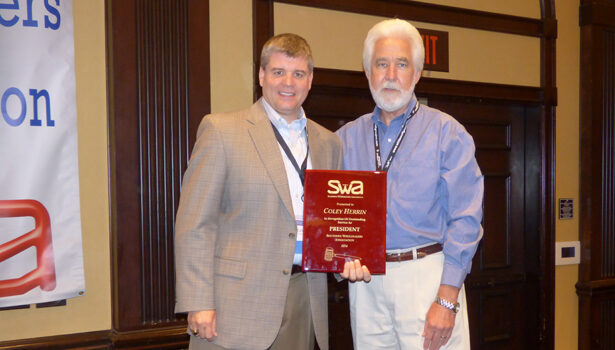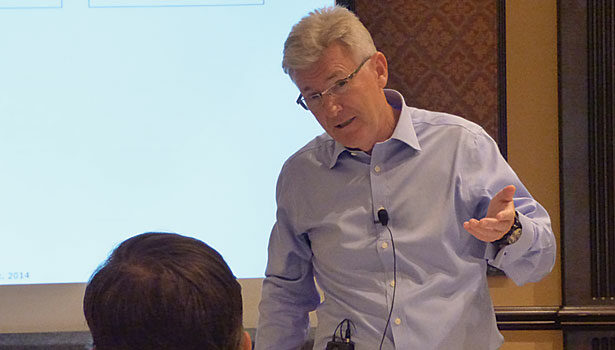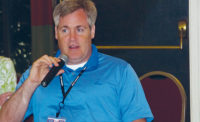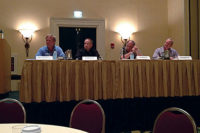The numbers keep climbing for the Southern Wholesalers Association.
SWA experienced another major surge in attendance at its recent 86th annual convention at the Hammock Beach Resort in Palm Coast, Fla., about an hour south of Jacksonville on the state’s east coast.
SWA Executive Vice President Terry Shafer told Supply House Times at the event about 700 total attendees were on hand in Palm Coast, a number much higher than 2013’s impressive 520 total in Hilton Head, S.C.
“We’ve seen a huge increase in attendance,” he said. “Part of it is our family program (attendees are encouraged to bring their spouses and children) has really taken off. If you look at the stats we have about 210 kids and 95 spouses here.”
Shafer said the organization’s Leadership Development Council young executives arm also is playing a role in the increased convention attendance numbers. “That group is really growing and with that growth comes more spouses and kids,” he said.
Shafer reported SWA has seen membership numbers spike over the last year with 15 new vendors, four new distributor companies and five manufacturers representative firms joining. “Vendor participation has been huge,” he said. “Our sponsorships are probably at a 20-year high. We’re seeing membership growth across the board.”
SWA’s annual golf outing that is part of the convention attracted 122 players. “The convention’s popularity is at an all-time high,” he said. “It pulls together a regional network of people that generally don’t get to see each other. The convention offers the opportunity to interact with peers from a large region.”
Schafer also praised the group’s Suppliers Advisory Council for its work. “The Suppliers Advisory Council is made up of key vendors and rep firms that have demonstrated loyalty through the years,” he said. “The council gives us very good ideas about how we can continue to change and make the convention valuable to our vendors and reps. SWA also has a great board of directors. We are very critical of what we do and are always open to things that will help this organization continue to be successful. Being critical of ourselves is the only way we can meet the changing needs of our industry.”
Outgoing SWA President Coley Herrin (Plumbing Distributors, Inc.) reflected on his term, which now heads into the home stretch of 2014. “My challenge to SWA is even though things are good with record attendance and sponsorship, let’s not be complacent,” said Herrin, who in an emotional moment, thanked mentor Sid Mealor (who started PDI with his father, Gladston Mealor), as well as his wife, Tammy. “Let’s challenge what we do and come up with new ideas and be flexible and willing to change. I want this to be a stop on the road to something bigger and better.”
Incoming President Travis Elrod (DeVore & Johnson), who was featured on the cover of the July issue of Supply House Times, also spoke at the general session. Herrin now shifts to SWA chairman of the board, while Harry Hays (American Pipe and Supply) moves to SWA chairman ex-officio. Cregger Co.’s Brendan Donohue becomes SWA first-vice president/treasurer. Noland Co.’s John Simmons is the new second-vice president.
Speaking out
SWA did not disappoint with its two guest speakers in Palm Coast. Ultra-marathoner Dean Karnazes, the general session keynote, had a packed house shaking their heads as he ticked off the mind-boggling amounts of running he’s done over the years. He’s run from Los Angeles to New York City with a stop in the White House front lawn; he’s run in 130° F heat in Death Valley (where his shoes started to melt on the pavement) and in Antarctica, as well as completing 50 marathons in 50 states in a 50-day stretch.
“The body is a remarkable machine,” he said. “It adapts to the load placed on it.”
Karnazes talked for about an hour in the general session and then moved across the resort for an attendee-fueled question-and-answer session. SWA attendees peppered the 51-year-old with question after question about topics ranging from his diet to what shoes he wears to how he goes to the bathroom on long runs.
Karnazes also offered some practical advice businesspeople can put to immediate use. “You have to be a master of your craft and commit to your goals and sacrifice,” he said. “If you sometimes come up short, never give up. Those willing to succeed don’t give up no matter how bleak the situation is. They will fight and scratch until they reach their goals. Stay focused on the finish line. Focusing on goals is very important.”
He added that taking the bigger picture and breaking it into smaller components also is helpful in all walks of life. “Break down large, seemingly impossible tasks into manageable pieces,” he said. “How do you run 1,000 miles? You run one mile 1,000 times.”
The convention kicked off with Ian MacDougall talking about corporate lifecycles. MacDougall tackled the main question of “What does it take to be a great company?” He considers a company in the “prime” stages as being a great company and stated the prime stage is the only stage where a company can dominate its markets and sustain a position of leadership.
He also shared what obstacles need to be overcome to get to that prime stage, what causes organizational aging and atrophy, and if those occur, can they be reversed?
MacDougall stressed an organization must perform the roles of produce, administer, entrepreneur and integrate in order to be successful in both the long- and short-run. He added if any of those roles are not being performed there will be mismanagement. He then went on to describe the characteristics members of an organization might display if they fit into one of those four roles.
He said a producer is interested in the “what,” and may be labeled a “lone ranger.” The administer role is zeroed in on the “how,” and manages by the book. The entrepreneur focuses on “why not?” and could be labeled as the “entrepreneur gone berserk.” The integrator is focused on the “who?” and could be labeled a “super-follower.”
“The producer makes things happen and motivates,” MacDougall said. “The administrator is a systematic, detailed process person. The entrepreneur is a creative, big-picture risk-taker and the integrator is a people person who is a likeable team player.”
MacDougall added a person who fits all four of those roles is highly unlikely to exist in an organization. “The first task is to ask yourself who am I?” he said. “If you don’t know who you are, you’ll never know who you need. The people you need should complement your style. Hire people who can disagree with you, but that you respect. Change creates conflict. The more conflict you can handle the bigger problems you can solve.”
MacDougall then revealed the various lifecycle stages a company goes through, starting in the courtship stage and going up to the coveted prime stage, and then down to the negative end of the spectrum with the bureaucracy and death stages.
MacDougall noted four key causes of organizational aging are relative perceived market share, the mental age of key people, organizational structure and leadership. He also offered some tips for dealing with changes and conflict resolution inside a company.
“Don’t let anybody attribute a problem to an individual. Don’t single anybody out,” he said. “Describe a situation, but don’t prescribe a problem. Instead of saying we need more outside salespeople, say our major accounts are not getting called on frequently.”
The 2015 SWA Convention returns to the Marriott Hilton Head Resort & Spa in Hilton Head, S.C., June 28-30.
